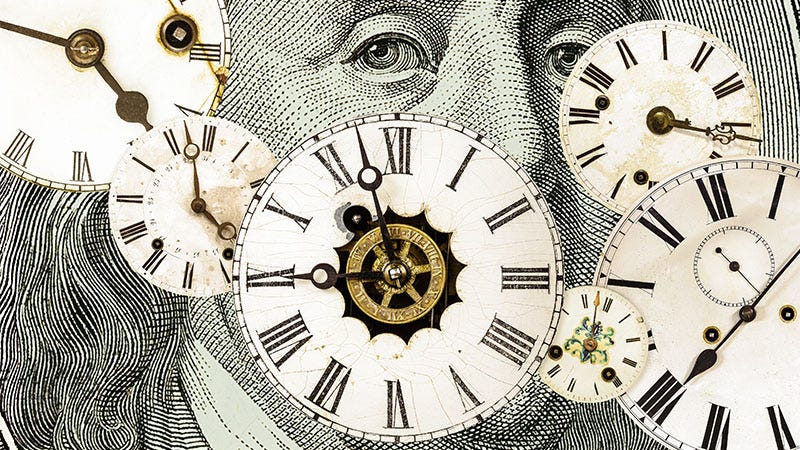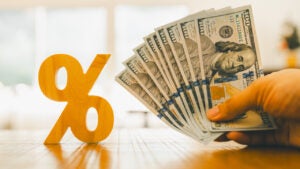Historical CD interest rates: 1984-2025

Certificates of deposits (CDs) continue to be worth considering as a component of your savings strategy in 2025. Yields on the best CD rates increased to highs not seen in years, thanks to the Federal Reserve raising its benchmark rate 11 times in 2022 and 2023. In 2024, yields dipped slightly after the Federal Open Market Committee (FOMC) cut rates three times that year.
The Fed held rates steady for much of 2025, before lowering them in September. While competitive CD rates have gradually decreased after peaking in late 2023, they still remain well above national averages and the rate of inflation.
“Savers can still take advantage of historically high yields on savings accounts and CDs, even as the Federal Reserve restarts a rate-cutting cycle,” says Stephen Kates, CFP, Bankrate financial analyst. “Savers shouldn’t worry as much about how yields compare to last year, as much as how they will compare to next year.”
Nearly 40 years ago, CDs were considered great investments. The average annual percentage yield (APY) on a one-year CD was over 11 percent.
But starting in 2009, in the aftermath of the Great Recession, average rates on shorter-term CDs were middling below 1 percent APY. And in the wake of the COVID-19 pandemic, the average yields for all CD terms, including 5-year CDs, plunged below 1 percent APY.
But in early 2022, CD rates started to climb back up with the onset of Fed rate hikes. APYs peaked in late 2023, before seeing some declines as banks anticipated the Fed would lower its benchmark rate in 2024.
The average one-year CD is 1.9 percent APY as of January 15, 2026. The most competitive banks are offering APYs of up to 4.25 percent on one-year CDs.
Here’s a look at the historical ups and downs of CD rates and some background on rate fluctuations through the decades.
CD rates in the 1980s
CD rates in the 1980s reached record highs. Savers had access to double-digit yields as inflation soared.
The U.S. faced two recessions in the early 1980s. That’s when CD yields peaked. On average, three-month CDs in early May 1981 paid about 18.3 percent APY, according to data from the St. Louis Federal Reserve.
The reason interest rates were so high in the 1980s was due to high inflation. With inflation, the cost of goods and services rises and your money doesn’t buy as much. And so, while savers enjoyed higher rates on their CDs, their spending power took a hit.
CD rates in the 1990s
CD rates fell in the 1990s and inflation was much lower than it was in the previous decade.
Following another short recession in the early 1990s, conditions improved and inflation fell. Overall, the decade was marked by a solid economy.
CD rates in the 2000s
CD rates declined in the early 2000s. Interest rates were reduced to help jumpstart the economy following the stock market bubble.
In early 2000, after the dot-com boom began to lose steam, the economy started to slow and the Fed lowered interest rates to stimulate the economy.
The average yield on one-year CDs fell below 2 percent APY in 2002, Bankrate data shows.
In September 2009, following the global financial crisis, the average one-year CD paid less than 1 percent APY. Average rates on five-year CDs were only slightly higher — about 2.2 percent APY.
Other rates fell, too, as the central bank slashed its benchmark interest rate.
CD rates from 2010 to 2019
After the global financial crisis, CD rates fell to their lowest point in U.S. history. Toward the end of the decade, rates began rising, but fell again in 2019.
The Federal Reserve’s efforts to stimulate the economy following the Great Recession of 2007-2009 left many banks flush with cash, so they didn’t need to boost rates on CDs to obtain money for lending.
CD yields reached historic lows. In June 2013, average yields on one-year and five-year CDs were 0.24 percent APY and 0.77 percent APY, respectively, according to Bankrate data.
As the Fed gradually increased its benchmark interest rate between December 2015 and 2018, savers started to benefit.
Then, the COVID-19 pandemic struck in early 2020, causing a worldwide economic earthquake. In March of that year, the Fed brought benchmark rates to near-zero levels to help support economic activity and strong labor market conditions.
CD rates from 2020-2023
As the COVID pandemic emerged in early 2020, the Federal Reserve lowered interest rates, but inflation caused a reversal of those decreases starting in 2022.
In March 2020, the Fed made a couple of emergency rate cuts as a result of the economic lockdowns brought on by the COVID-19 pandemic. Here’s how CD rates fell in the year after those emergency rate cuts of 2020 were made:
- From June 2020 to June 2021, the average one-year CD dropped to 0.17 percent APY from 0.41 percent APY.
- From June 2020 to June 2021, the average five-year CD fell to 0.31 percent APY from 0.6 percent APY.
However, average CD rates shot up in subsequent years. In September 2023, one-year CDs averaged 1.92 percent APY and five-year CDs averaged 1.29 percent APY.
This was largely due to the fact that the Fed hiked rates 11 times in 2022 and 2023, incentivizing banks to charge more on loans while also paying out more on the best high-yield savings accounts and CDs. (The federal funds rate has an indirect effect on CDs.)
Current trends in CD rates
Average CD APYs dipped leading up to the first Federal Reserve rate cut of 2024, which took place on Sept. 19. Shorter terms of six months and one year consistently earned higher average APYs than five-year terms.
CD rates have decreased from their current-cycle peak in November 2023 in anticipation of and after the Fed’s decision to cut rates three times in 2024. Persistent inflation and a slowing labor market influenced this move. But top CD rates and savings accounts are still outpacing inflation.
CD yields stabilized during the first and second quarters of 2025 after the FOMC voted in its first three meetings of the year to maintain the federal funds rate at its current target range of 4.25-4.5 percent.
Looking at the national average CD rates, you can see the relative health and stability in CD rates in the last year. Bankrate’s rate survey data as of June 2, 2025 shows:
- The national average one-year CD yield was 2 percent APY, compared with an average yield of 2.08 percent around a year earlier.
- The national average five-year CD yield was 1.72 percent APY, which is higher than the rate of 1.49 percent around a year ago.
Impact of Federal Reserve decisions on CD rates
APYs on savings products and deposit accounts tend to move when the Federal Reserve’s interest rate changes. When the federal funds rate declines, there will often be a decline in deposit rates for top-yielding CDs and savings accounts. Similarly, when the federal funds rate increases, you’ll likely see an increase in deposit rates.
This relationship occurs because the federal funds rate is a benchmark for the cost of money in the banking system. When the Fed raises or lowers its rate, it may influence the rates banks pay to secure deposits used to fund their lending and investment activities. Note, though, that not all banks will change their rates in response to the Fed’s moves and there are other factors that could impact rates. Some banks, especially big banks, will pay rock-bottom rates no matter what the federal funds rate is.
Effect of economic conditions on CD rates
Macroeconomic conditions also impact CD rates. Although CD yields are often tied to the federal funds rate and not directly to a recession, the impact of a recession filters through.
A recession usually occurs after a series of Fed rate hikes. High inflation followed by an increase in the federal funds rate to lower inflation could eventually lead to a recession. In this event, the Fed would respond by lowering the benchmark federal funds rate. Consequently, CD yields would start to decline.
During and long after the Great Recession, which took place from December 2007 to June 2009, CD yields demonstrated prolonged aftershocks. For example, yields on one-year CDs hovered below 0.50 percent APY for nearly eight years. One-year CD rates were close to zero once again for roughly two years during the COVID-19 pandemic.
Forecast: Where CD rates are heading
Competitive CD APYs have been declining gradually since before the three 2024 Fed rate cuts. They may continue to decline following rate cuts in 2025.
“The Fed is restarting its rate cutting cycle, but there are no guarantees as to how quickly or how long the cycle may last,” Bankrate’s Kates says. “As the federal funds rate declines, yields on CDs and savings accounts will likely follow gradually. Savers should be prepared to adjust their strategy as conditions change.”
Despite potential declines, some experts anticipate that CDs will continue to outpace inflation. As of this writing, the current annual inflation rate is 2.9 percent while the highest yield on a one-year CD is 4.25 percent APY.
Bottom Line
Despite fluctuating rates over the years, CDs once again proved to be a worthy investment in 2024, and they’re worth considering for savers in 2025. Although the Fed did lower interest rates — after bringing them to a 23-year high — APYs on competitive CDs remain well above the current rate of inflation. To make the most of high APYs, compare top CD options and find the highest rate at the right term for your needs.
* In June 2023, Bankrate updated its methodology that determines the national average CD rates. However, the data in this article’s graphs is based on historical data from Bankrate’s previous methodology.
Why we ask for feedback Your feedback helps us improve our content and services. It takes less than a minute to complete.
Your responses are anonymous and will only be used for improving our website.







